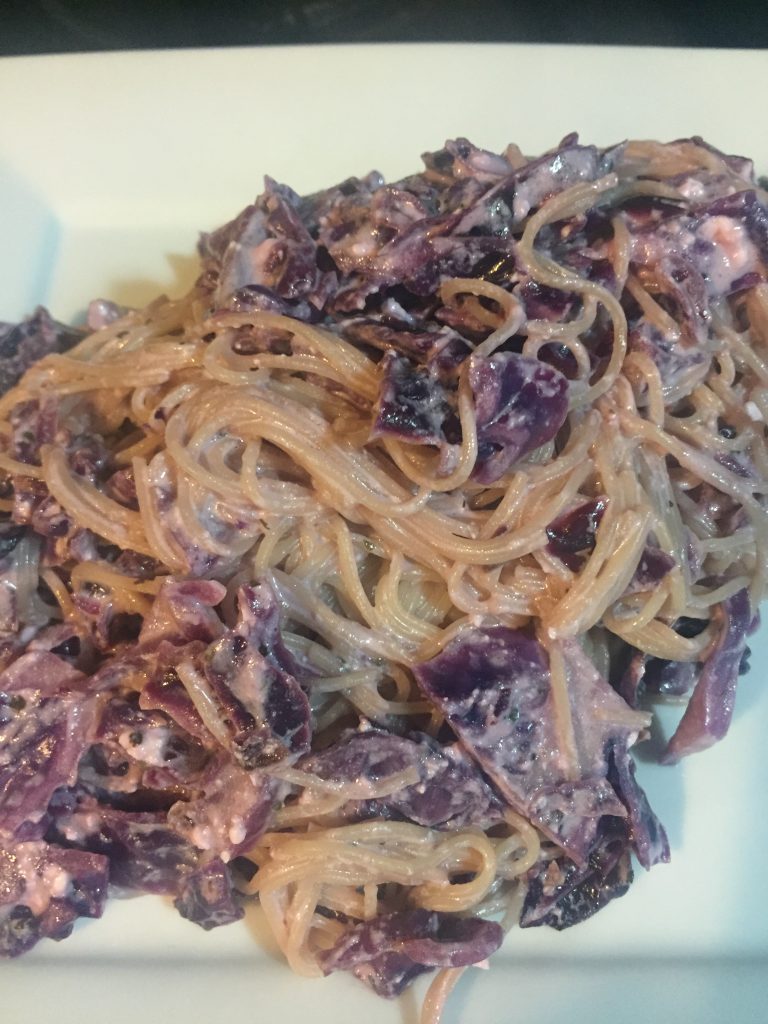
When in 2009 I moved from Arizona to Alabama, I did so on about three days’ notice. My friends packed my apartment while I attended to the things they couldn’t help with, and into the box for my kitchen, they put one pot, one pan, and a few plates and utensils – enough to tide me over until the rest of my possessions arrived by van in about six weeks’ time. During those first six weeks, I ate cabbage pasta virtually every night. It had the critical advantage of being the one vegetable-oriented meal I knew how to cook, and moreover, it was cheap: pasta costs about $1 per box, and cabbage isn’t much more expensive. For the price of one box of pasta, one purple cabbage, a gallon of milk, and a block of feta cheese, I could get three or four nights of dinner. So can you, if you don’t hate cabbage. The original version, which one of my apartment-packing friends invented, calls for fresh mint and cream, but if you are a hungry college student you can get away with no mint and whole milk. The version I’ve made for this post is somewhat of an intermediate version, using dried mint, half-and-half, and a few extra ingredients to amp up the flavor.
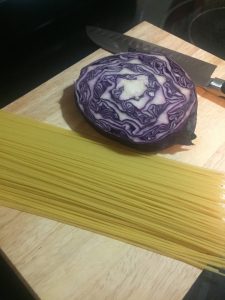
You Will Need:
- Olive oil
- Purple cabbage (one good hunk; I’ve included the picture of the raw ingredients above so you can get an idea–this makes enough for two meals)
- Salt
- [Optional] Juice of 1/2 lemon
- Pasta (I like to use angel hair, but you’ll have to really slice the cabbage thin to get it to twirl on your fork with your pasta; use farfalle if you don’t want this hassle)
- Heavy cream or half-and-half (substitute whole milk if on a shoestring budget)
- Fresh or dried mint (use four or five good-sized leaves if you have fresh; the flavor adds a lot to this dish)
- Salt
- [Optional] Garlic powder
- Feta cheese
Two available burners on your stove, plus a third if possible
Nonstick skillet
Knife/cutting board (or mandoline)
Wooden spoon
[Optional] Citrus juicerLarge pot for cooking pasta
Pasta strainer (or slotted spoon for removing pasta from water)
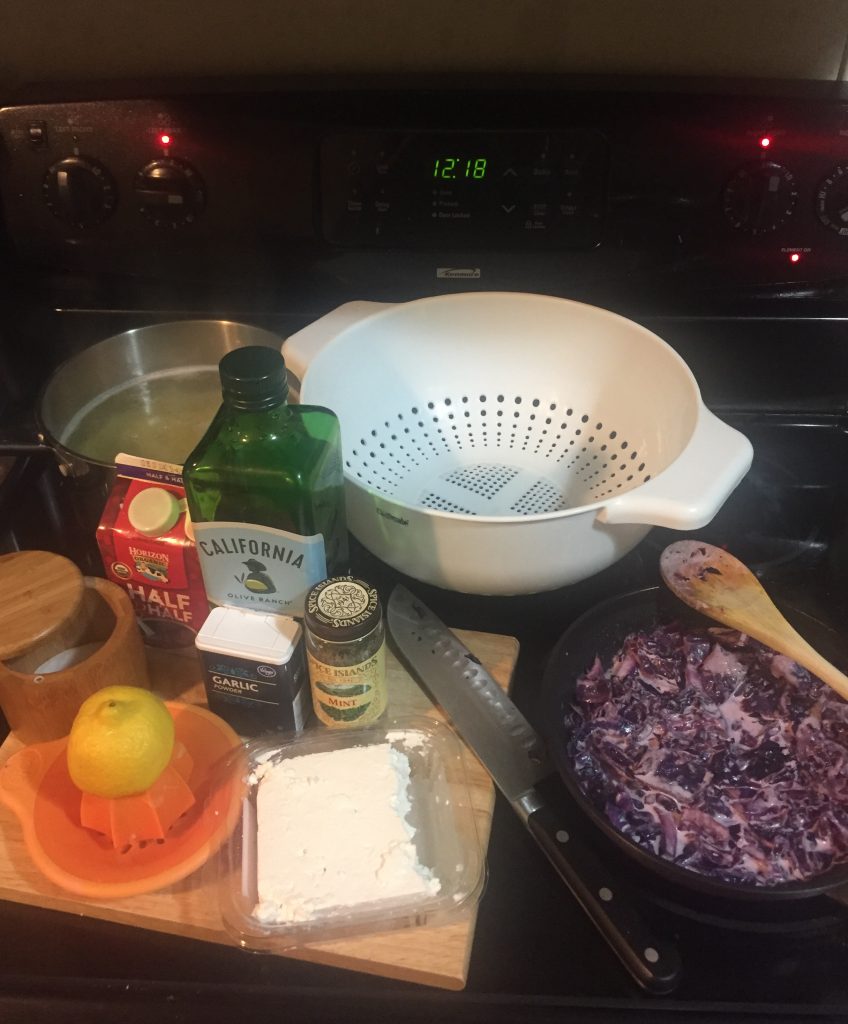
Steps
1. Heat a glug of olive oil in a nonstick skillet over medium-high heat.
2. Shred/slice the cabbage using either a knife or a mandoline. Finely chop the mint if using fresh mint, but set it aside for later use.
3. Add the cabbage to the skillet with a good pinch of salt and the lemon juice (if using). Stir. The cabbage will turn pink from the lemon. Leave it to cook (you want it to wilt), but stir it periodically so the bits on the bottom don’t burn.
4. [Optional] Turn a spare burner to low heat (3 or 4 on most stovetop dials) and let this burner heat up. The goal is to wilt the cabbage over high heat and then transfer it to low heat so you can add the cream without it breaking. You won’t need this step if you are lucky enough to have a gas stove.
5. Fill a large pot with salted water and bring the water to just below a boil. Do not add the pasta yet.
6. When the cabbage seems soft enough to eat without crunching, transfer the pan to the lower heat setting and let it sit for a few minutes to cool down.
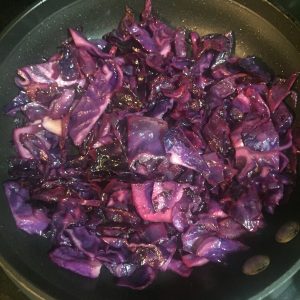
7. Bring the water to a boil and add the pasta to the water. If you are using whole milk instead of cream, or if you are using angel hair and prefer your pasta al dente, wait until after you have completed the next step. Check out my post on cooking pasta if you need advice about how to know when the pasta is done.
8. Once the cabbage is still hot but so longer spewing steam, add the half-and-half (cream), mint, and garlic powder to the skillet. Stir and let simmer. Bear in mind that heat will cause the cream to reduce, and half-and-half will take longer to reduce than heavy cream. (Milk will take longer still; in this case, add the same amount as you would heavy cream and delay starting the pasta until at least half of it has evaporated.) As a general rule, I try to add enough liquid to cover the bottom of the skillet plus some extra if I’m using cream. Obviously, the larger your skillet the more liquid you’ll end up using, but your rate of evaporation will also be higher, so the two variables will more or less cancel one another out.
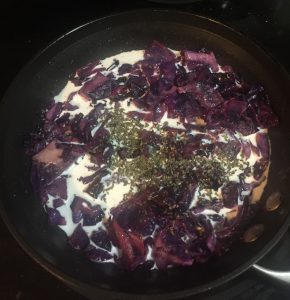
9. Keep an eye on both pans, which should be ready at around the same time. When the pasta is done, drain immediately. You’ll know the cabbage is ready when the liquid has thickened. Taste the cabbage to check for flavor and adjust as necessary (remember that you’ll be adding feta, which is salty, so in most cases you’ll need to add a splash of lemon juice if it seems bland–don’t go overboard, since the juice can curdle the cream).
10. Add feta cheese to the cabbage and stir. Let everything sit for a minute or two, just long enough to soften the feta.
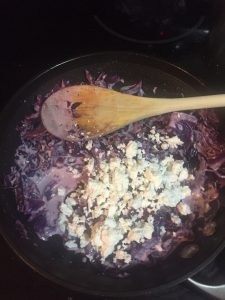
11. Combine cabbage and pasta in whichever of your two pans is larger. Stir everything together until the noodles are coated with the purple cream, then serve hot.
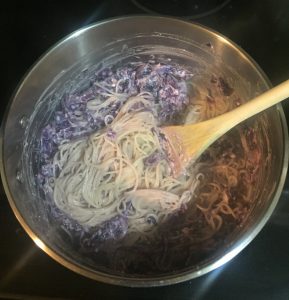
Important Notice About November Blog Posts:
November is National Novel Writing Month (NaNoWriMo). Since I write fiction when not working on Ditch The Ramen, I’ll be limiting my posts this month to Thursdays only in order to devote extra time to the piece I’m creating in conjunction with the NaNoWriMo challenge. Thanks for your understanding. 🙂


